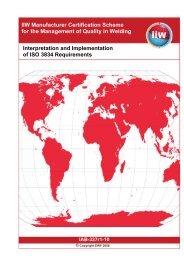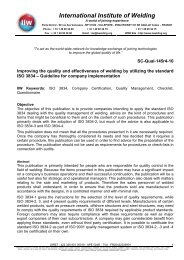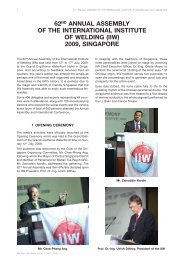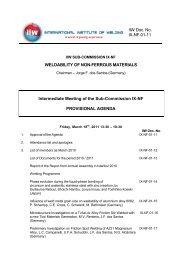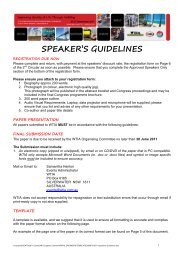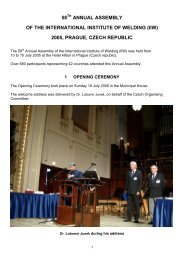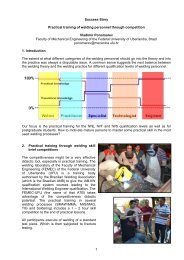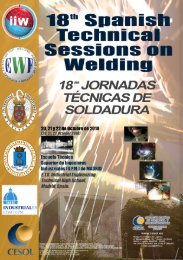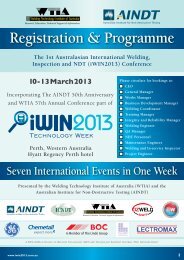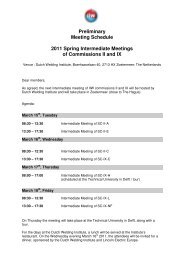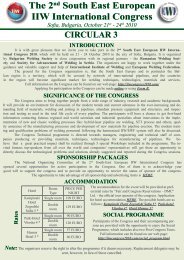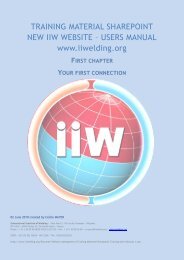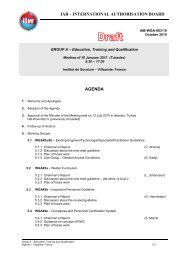2010 - IIW
2010 - IIW
2010 - IIW
Create successful ePaper yourself
Turn your PDF publications into a flip-book with our unique Google optimized e-Paper software.
An example to this case could be seen in Figure 1 where<br />
same steel is welded at different positions using<br />
accordingly different welding process and consumables.<br />
PA refers to submerged arc welding (SAW), PC and PF<br />
are gas shielded flux cored arc welding with different<br />
heat inputs. It is most probable that these different<br />
welding positions (process variations) may lead to<br />
different joint properties and hence welded structure<br />
depending on the loading conditions may differ at<br />
different points.<br />
Therefore, it is essential to consider weld joint<br />
performance an integral part of the welding process and<br />
local properties (strength, notch etc.). For example,<br />
welding process parameters and selected consumables<br />
and base metal grade of line pipes are of major<br />
importance for the integrity of pipelines. The use of<br />
fitness-for-service analysis at the design stage will<br />
enhance the accuracy of the decisions and hence will<br />
improve the productivity, safety of welded fabrication<br />
and integrity respectively.<br />
Weld joints usually exhibits heterogeneous properties<br />
across the joint. This particularly effects the<br />
performance of the structure. For this known reason<br />
weld strength mis-match has been a topic of research<br />
for same time. This paper gives special attention to this<br />
topic.<br />
2. Weld Strength Mis-match<br />
Structural weld joints, particularly bi-material<br />
(dissimilar) joints usually exhibit substantial mechanical<br />
heterogeneity with respect to elastic-plastic deformation<br />
and fracture properties. This heterogeneity is commonly<br />
called as „strength mis-match“ and expressed as yield<br />
strength mis-match;<br />
assisted cracking. In addition to this difficulty, there<br />
exists unintentional strength undermatching in high<br />
strength steel weldments. The weld joints may<br />
unknowingly be undermatched because the base metal<br />
has much higher yield strength than the SMYS<br />
(specified minimum yield strength). It should be noted<br />
that the undermatched welds can have a significant<br />
effect on the strength level, resistance to fracture and<br />
ductility of welded components. The undermatched<br />
welds are particularly sensitive if the welds operate<br />
under tension perpendicular to the weld seam. If the<br />
undermatched welds are loaded in a direction parallel to<br />
the weld length should present no problem, since the<br />
strain will not localise in the soft weld seam.<br />
Particularly, since early nineties, numerous<br />
investigations have been conducted by the author [e.g<br />
1-6] to describe the effects of mis-matching on the<br />
fracture behaviour and toughness. Two special<br />
international conferences, Mis-match 93 [7] and Mismatch<br />
96 [8] have provided international forum and<br />
showed the significant progress had been made in<br />
this field. For example, currently, unified method to<br />
perform defect assessments in mis-matched welds<br />
exists. In this context, recently developed fitness-forservice<br />
procedure FITNET has provided clear<br />
guidline for assessment for such welds. However,<br />
significant amount of work is still needed,<br />
particularly in the areas of high strength steel<br />
weldments, treatment of HAZ softening and highly<br />
undermatched Al-alloy weldments while extensive<br />
validation cases of proposed approaches as well as<br />
treatment of material-mix (multi-material) structures<br />
are still missing.<br />
M=σ YW /σ YB<br />
Over-Match (OM)<br />
Under-Match (UM)<br />
Where σ YW is the weld metal yield strength and σ YB is<br />
the base metal yield strength. It is referred to as<br />
„overmatching if M>1 and called as „undermatching“ if<br />
M YS W<br />
Under-Matched<br />
B<br />
YS W<br />
YS B < YS W<br />
Figure 2. Schematic description of crack tip plasticity due to<br />
weld strength mis-match. LBW: Laser Beam Welding, FSW:<br />
Friction Stir Welding<br />
2H



